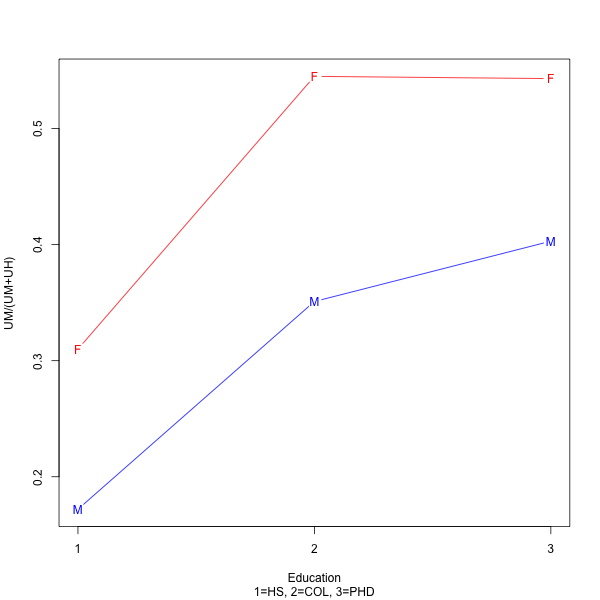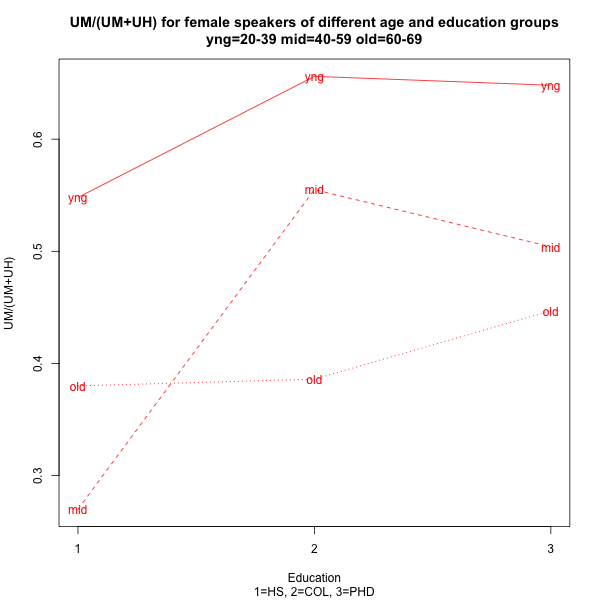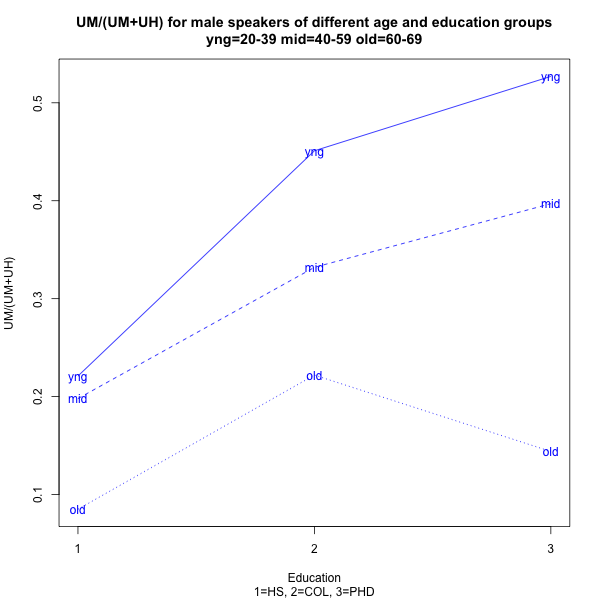Educational UM / UH
« previous post | next post »
Apologies for temporarily turning this into Conversational Filler Log — but I realized that my assertion in this morning's post ("UM / UH geography") about the effects of years of education was based on some analyses that I'd done but never posted.
So here they are: the basic effect is that people with a 4-year college degree or better have a higher UM / (UM+UH) proportion, on average, than people with only a high school education. This interacts as expected with sex and age: at every educational level, women have a higher UM proportion than men do; and in general, younger people of whatever age and educational level have a higher UM proportion than older people (though the number are small for some of the intersected categories, so that the patterns are a bit messier).
From LDC conversational data (Switchboard, Fisher 1 & 2):
And breaking things out by age as well as sex and educational level:



Coby Lubliner said,
August 13, 2014 @ 11:30 am
Mark: can you explain the apparent discrepancy between what you just wrote,
and what you wrote in the previous post,
Why would the need for more time favor UH over UM?
[(myl) I meant this story to be an example of the type of hypothesis that would be worth exploring — I have no evidence that it plays a role in the UM / UH phenomenon.
But it's well established that older people need more time to go from semantics to words (e.g. in picture naming or in listing words for members of a semantic category). There's a recent and interesting controversy about why this is true — see e.g. Ramscar, M., Hendrix, P., Shaoul, C., Milin, P. & Baayen, R.H. (2014) The myth of cognitive decline: Non-linear dynamics of lifelong learning. Topics in Cognitive Science, 6, 5-42.
But the facts are not in doubt. So if UH is (often) a sign of taking extra time for lexical access, then increasing UH frequency with age would be predicted.
For my story to work, UM must (often) play some other role — and my (unsupported) suggestion was that it might tend to represent delay in deciding what to say (or whether to say it), not delay in determining how to express an idea once the speaker has decided to do so. It's possible that as people get older, their stock of opinions might become larger, better rehearsed, and more strongly associated with triggering topics, so that the need for (this kind of) UM would decline.
Why would UM and UH differ functionally in this way? It might be just the usual arbitrariness of linguistic signs, or there might be some sort of phonetic symbolism at work.
Again, there's no evidence for this explanation, as far as I know — the point is just o spin out an example of the kind of story that might lie behind (one aspect of) the clear, robust and puzzling facts about UM / UH usage. And the associated claims about functional differences between UM and UH are subject to test.]
Elonkareon said,
August 13, 2014 @ 1:07 pm
Coby: Perhaps because UM ends and UH trails off? I mean, it doesn't *have* to end, but it's a bit harder to continue the nasal than the vowel.